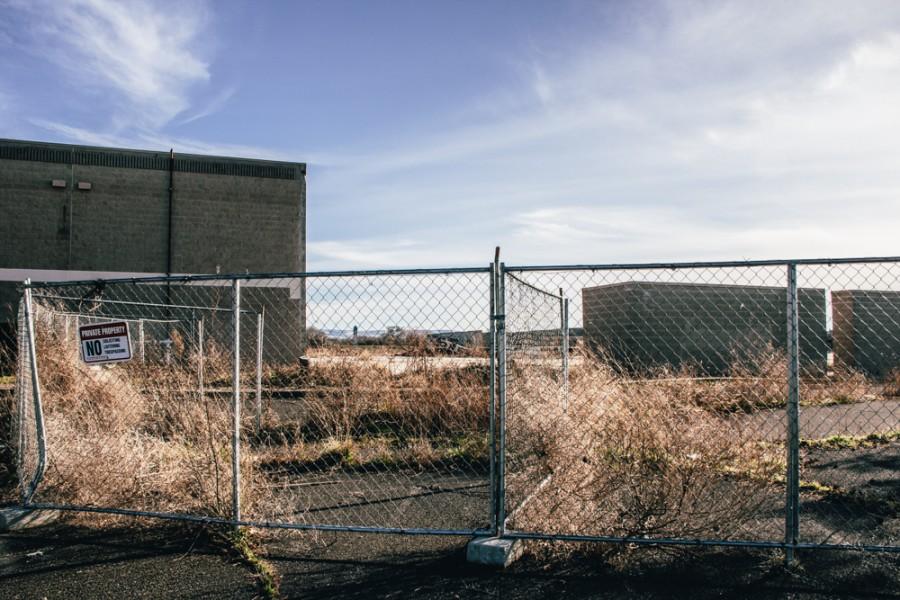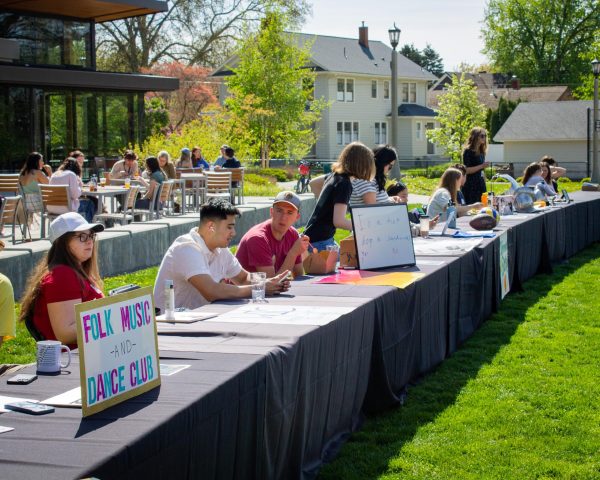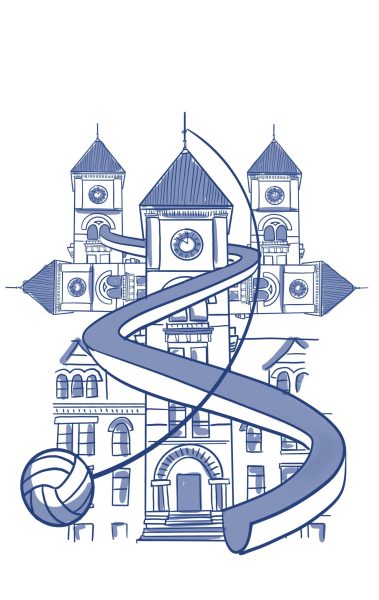Walla Walla Town Center to See New Life
After nine immobile years, retail businesses will soon fill what used to be the Blue Mountain Mall.
March 3, 2016
Walla Walla’s Blue Mountain Mall sits lonely on the corner of Myra and Rose. Its only store, a Shopko, is surrounded by vacant buildings. Some are gutted while others are lost in states of transition, their skeletal walls crumbling and consumed by shrubs and graffiti. The mall sits on potential and harbors hopes that Walla Walla could, after a long decade, open the retail businesses that its citizens have been craving for years.
It appears that this transition is taking shape. According to president of development company Real Estate Affiliates (REA) Alan Gottlieb, the project should break ground in the fall of 2016 and stores should begin opening in April or May of 2017. Tenants have yet to sign their lease, but according to City Manager Nabiel Shawa approximately 8 businesses have signed commitment contracts to open in what will be newly named Walla Walla Town Center. Forever 21, T.J. Maxx, Ulta, Bed, Bath & Beyond, Hobby Lobby, Ross, Famous Footwear, Shopko, and other small restaurants will fill the empty spaces. More retail shops are yet to sign but the official list of tenants will be available within the upcoming months.

“Walla Walla is fortunate in that the people that purchased [spaces] were described as stalwarts; they are very well established, have great reputations and they have the ability to put the shopping center back on track,” Shawa said.
The shopping center opened in 1989 and was home to four large businesses: Shopko (the only remaining business), Fred Meyer (which became Troutman’s Emporium in 1992), Sears, and J.C. Penny (which became a Gottschalks). By 2007, the mall had lost of its tenants except for Shopko.
It was around this time that a developer purchased the area, gutted Sears and Gottshalks, built the walls for three new buildings and was lining up businesses to open in the vacated spaces. Then the recession hit. The developer absconded funds from the project and went overseas, leaving what Shawa estimates was around 24 million in debt. At this time Key Bank repossessed the site and put it on the market. A Southern California based development firm, REA, purchased it in 2013 and has since been organizing plans for retail businesses to come to Walla Walla.
There has been a growing amount of anger amongst citizens due to the slow progression of this project. One Facebook page entitled ‘Save our Blue Mountain Mall’ has taken the lead for the past 5 years on posting pictures and occasional updates on the lack of development.
“Oh January 2016, here you are and The Walla Walla Blue My(sic) Mall still looks like a garbage dump! I am so tired of looking at it. To all those who said it would get cleaned up and new businesses were coming in, ha! Somebody PLEASE do something!” said page owners on Jan. 22.
Shawa knows from a citizen satisfaction survey released in 2015 that one of the top four wants of Walla Walla citizens is retail businesses. He also recognizes that more retail means more sales tax which is one of the main sources of income for the city. In 2007, Walla Walla reached its all-time high regional sales tax at 4.9 million. The recession brought this number down by approximately 1 million, but the 2015 reports show tax is back to around the amount of 2007. Additionally, Walla Walla is losing approximately 40 million in revenue due to outside retailers in places such as the Tri-Cities, a condition called leakage.

“We’re at the cusp–there’s a lot of disappointment with the citizens that this has not broken ground, but believe me the city wants to see this development,” Shawa said.
The complications for beginning the project lie in attaining tenants, national retailers, to agree to open a store in a town that has little data on citizen buying attitudes. Besides Walmart, Macy’s, Joanns, Staples, and a few grocery stores, Walla Walla does not have national retailers.
“Nobody can really project accurately what sale volumes may be in Walla Walla because it’s mainly independent tenants, so it takes a while for these retailers to understand that marketplace,” Gottlieb said. “It’s educating those retailers and it takes a lot of time to get that done but we’re pretty much there at this point in time.”
These new retailers will open potentials for Walla Walla consumers–new shoes, clothes, and soaps in a short 10 minute drive–but what will its effects be upon other smaller retail businesses? In the late 1980s-1990s, when the Mall had just opened, Main Street reached its all-time low. Small businesses closed and the Mall only worsened a local economy that was on the downfall. It was at this time that City Hall and some of the business leaders started the downtown revitalization. Old architecture was restored and wineries began to repopulate the downtown area.

“For every dollar we put with [the Town Center] we need to spend 2 hours and 2 dollars on Main Street because that is what all of the businesses around small towns are trying to do, they’re adding vibrancy and business to their main streets,” Shawa said.
Shawa believes that the increased tourism from the wine industry and Main Street’s charm will ward off any potential threat that the large retailers might bring, building Walla Walla’s vitality across its corners.










john • Jul 4, 2016 at 2:47 pm
I don’t quite understand how the mall worsened the economy for Walla Walla. Everything that is sold is taxed and sales tax is a way for a town to earn its revenue. At one time the Blue Mountain Mall had alot of establishments in operation. I heard the stores left because of too high of rent. It sure would have been nice if it was still going instead of having to go to Kennewick’s mall all the time for shopping. I don’t think they should have demolished out the middle. There was really nothing wrong with the original layout of the mall. Sometimes I wonder if Walla Walla’s wine industry is a little over-rated. There is so much limelight on wine and not enough on retail stores for Walla Walla. As far as I’m concerned there is no reason the indoor mall concept can’t work. All you’re doing is taking stores and places that people normally go to and taking them from an extroverted(outside) environment and puting them into an introverted(inside) environment. Furthermore the one big problem with stores in a downtown Main st. environment is there is almost always a shortage of parking spaces while a mall has abundant parking spaces. That’s one of multiple reasons that makes an indoor mall a great concept.
Jacqueline Holder • Jul 20, 2017 at 1:07 pm
I agree An enclosed Mall will be beneficial especially during the winter snow months!!
I’m a retired senior on a fixed income. I lived in South Central Texas for 35 years. Corpus Christi and the Texas Hill Country and San Antonio. I was spoiled to many Mall’s, yes a few lapsed. But came back to life.
One stop shopping is an asset.
The socializing is a must! SS a Senio,r I would love a safe environment to exercise by mall walking!! 24/7
With signed leases it seems to be very promising! Build and they will come! Buyer’s and retailer’s.
We need more chain restaurants. Like Chili’s Bar and Grill; Red Lobster; Cheddar’s; Red Robin to name a few.
Retailer’s like Costco; Winco; Lowes . I don’t want to or seldom drive to TriCities, especially in enclimate weather!
Bring it I will buy and support!
This is a real shot in the arm for Walla Walla when Adventist Health is departing!!
Lorraine Larsen • May 30, 2016 at 8:54 pm
My husband and I just visited this city over the long weekend thinking we might retire there from Seattle. One of the good things is the sun and weather. Hospitals are also important. Shopping is important too. I’m not a WalMart person. We liked that there is a Home Depot. But there is a lack of shopping and being retired and older, I don’t want to drive 50 miles for good shopping. Someone mentioned to us that this mall was going to make a come back. I believe that malls are dying off and many are becoming ghost towns and even churches. Walla Walla can use some good shopping. It doesn’t necessarily need to be a “shopping mall”, but a shopping district with national named stores would be important. Maybe a Costco?!
RV • May 5, 2016 at 5:12 pm
BRING IN OUTLET STORES!! Can you imagine how many people would flock to Walla Walla if we had outlet stores? It would boost tourism. I’ve been saying this since I moved here, a little over a year ago. As soon as I saw the old mall, I thought, what a perfect opportunity for outlet stores. A mall is so corny and outdated and Walla Walla doesn’t really have the population for a “mall”. If you stuck outlet stores in there, people from Tri-Cities, people from Portland, people from all the surrounding cities and towns would come here. Cheap shopping and wine!! Sounds like the perfect girls weekend. If you think I’m crazy, I’m not. I’m a woman that likes to shop, but I like good deals and so does everyone else. I have driven hours to go to get to closest outlet store and I didn’t just shop there. I ate at nearby restaurants, I even stayed at a hotel because I didn’t feel like driving back. The stores that are mentioned above are great. I’ve shopped at all of them, but bring in something a little more high end…but not full price high end..discounted outlets!!!! COACH, NIKE, COLUMBIA. It would work!! A mall will burn out………….but I am excited for the new shopping options.
Rachel • May 5, 2016 at 10:50 pm
I agree an outlet mall would be fantastic, but it wouldn’t attract people from Portland. There’s an outlet mall in Woodburn.
houx • Apr 13, 2016 at 10:09 am
Turn into a refugee camp.
Heather • Mar 30, 2016 at 8:27 pm
I’ll believe it when I see it! But I hope it goes through this time so we get more places to shop
Justin • Mar 8, 2016 at 7:34 pm
I’ll believe it when I see it, time after time it’s been said, were bringing & still nothing, it will be nice not to go to tri cities all the time. To eat good food & buy clothes, shoes.:-)
Zack • Mar 5, 2016 at 10:10 pm
The list of businesses that have committed to be tenants needs to be separated by semicolons and not commas because Bed, Bath and Beyond has commas in its name. It should read, “Forever 21; T.J. Maxx; Ulta; Bed, Bath & Beyond; Hobby Lobby; Ross; Famous Footwear; Shopko, and other small restaurants . . .” The way it is written now makes it seem as if Ultra is a store, Bed is a store and Bath & Beyond is a store.
Meg • Mar 10, 2016 at 5:41 pm
ULTA (not Ultra) is a store.
G.Shoun • Mar 5, 2016 at 3:22 pm
This is the same story as before and I do not believe a word of it. They will pay some taxes and do nothing again. You are all fooling yourselves if you believe them. Shoes? Clothes? And the best one is….Soaps? Not going to pay the rent folks. Nice try.
Zack • Mar 6, 2016 at 9:08 pm
I agree. Shopping malls are slowly dying off across the country because people don’t want to go to the mall like they once did. I remember when the Blue Mountain Mall was open. It was a depressing ghost town long before it closed. If these kinds of mall shops move in, the mall will die for the same reason it did before. If the idea is to bring money and business back to Walla Walla from the surrounding areas, a business model based on something that has become an icon/relic of the 1980s can’t be a good idea.
Orval Cowles • Mar 5, 2016 at 2:40 pm
I have been working at Shopko for 27 years enjoying every minute. Retail had it up and down but you have to be willing to change. Working in retail is like Christmas 365 days a year. Without completion or some store be there to fight or compete against Shopko is on a island by itself. BRING Walla Walla back to LIVE.
Judith Fortney • Mar 5, 2016 at 1:50 pm
thank you for the information, I appreciate being informed. Am looking forward to shopping here.
Carol tegland • Mar 5, 2016 at 11:48 am
If we want to entice new business, don’ t you think if the site was cleaned up and made presentable it would be more inviting. Why has the city sit on this looking like a dump for so long. It is a total embarrassment to the whole area! As a home owner I don’t think the city would allow me to let my property look like this, without taking measures to get it cleaned up. We have already lost one store that was ready to come in because of the mess down there.
Benjamin Grote • Mar 4, 2016 at 9:18 pm
If they would have kept that mall together, WALLA WALLA would have had a CENTER ! Now we have things all spread out. Walmart and most of those stores would have located their along with many others. GLAD TO SEE PROGRESS !